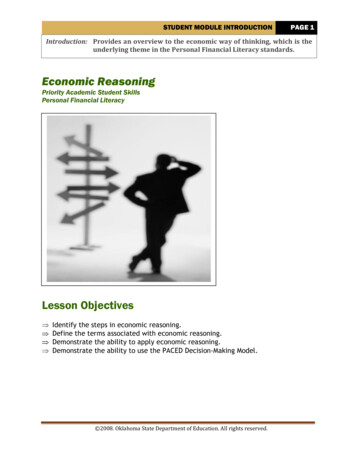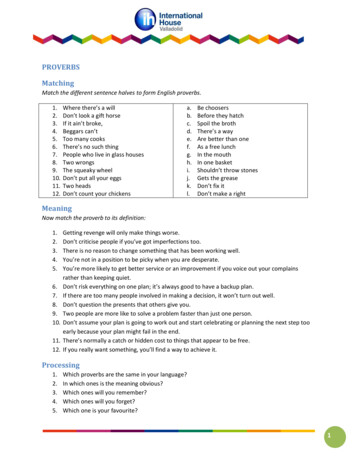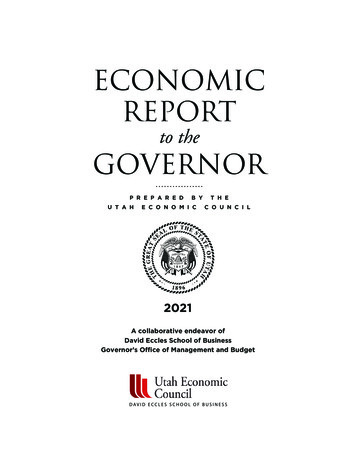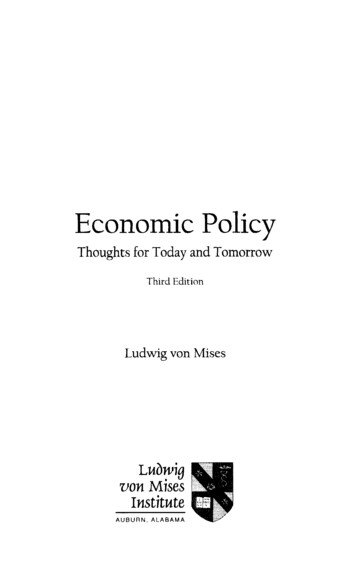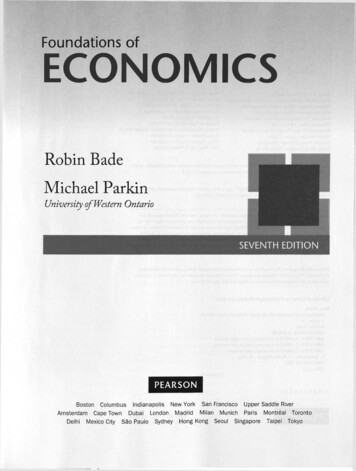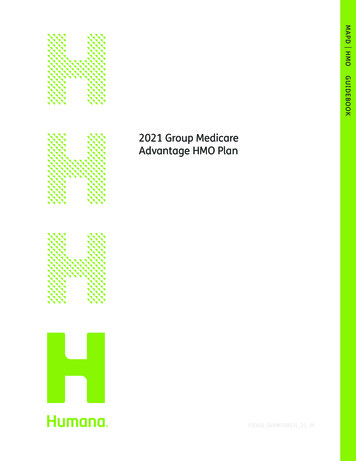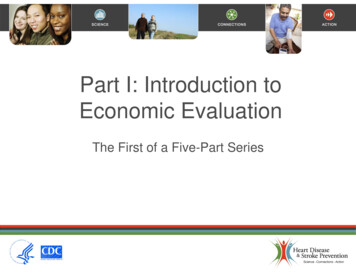
Transcription
Part I: Introduction toEconomiic EvalluatitionThe First of a Five-Part Series
Welcome to this five-part web presentation series on Economic EvaluationMethods.Here are some questions to think about:o How do you really know you’re making the most of your limited resources?o How do you decide between two promising program options when you canonly afford one?o How do you demonstrate to decision-makers that the benefits of yourprogram are worth the costs?The answer is economic evaluation—a powerful tool that can help with all thesesituations.This series is designed to introduce you to a number of important concepts that willhelp you understand the value of economic evaluation and how to incorporateeconomic evaluation methods into your programs.The four types of analysis that we will discuss in this series are:o One: economic impact analysiso Two: programmatic cost analysiso Three: benefit-cost analysis, ando Four: cost-effectiveness analysis.We will also discuss cost-utility analysis, a special type of cost-effectivenessanalysis.In Part One, we’ll define these terms and explain how economic evaluation canhelp you. The modules that follow will walk you through the process you woulduse to develop and conduct each of these types of analyses.
Why Care About Economics Within theContext ooff Public Health? We want to maximize outcomesand minimize costs. Limited resources hard decisions. Return-on-iR tinvesttmentt (ROI) shhowshow much value we get from ourspendiding deciisiions.2
As public health practitioners, we care about improving the health of the entirepopulation, so we try to maximize health outcomes. But why should we care abouteconomic issues in public health?Both public health managers and economists would agree that maximizing healthoutcomes is an important goal. However, public health interventions, programs,and policies all have costs, and from an economist’s perspective, keeping thesecosts low is also an important goal.If we lived in a society with unlimited resources to use any of the interventionsavailable, then we might not care so much about minimizing costs. But our realityis that financial resources for public health are scarce, and the situation is onlygetting worse. Therefore, we want to demonstrate the value we gain from theresources we use. Another way to put this is to say that we care about societalreturns on our investment in public health.
Public Health Model for Prevention3
To identify problems we hope to address, we use surveillance to determine theburden of a disease. Surveillance takes into account incidence, prevalence, andmortality rate. In gauging the economic burden, surveillance provides informationon the medical costs and losses in productivity associated with a disease.We also look at the causes of a disease to determine the risk and protective factors.Information about these factors helps refine our surveillance systems and identifyhigh-risk populations and others who might benefit from public healthinterventions.Program and policy development are also important. Programmatic cost analysis ispart of this process.Evaluation of an intervention, program, or strategy’s effectiveness looks at howwell it reaches its intended goal of improved health outcomes. In contrast,economic evaluation helps us understand the cost factors related to an intervention.Economic evaluation can be conducted prospectively or retrospectively. Forexample, economic evaluation can be used before recommending broadimplementation of an effective program or strategy.
Cost of Illness Analysisy Estimates total costs of a disease orcondition:– Medical and nonnon-medicalmedical costscosts.– Productivity losses. GenerallGlly reportedd as:– Annual total cost.– Average patient lifetime cost. Shows potential benefits of preventionprevention.4
The first type of economic evaluation—economic impact analysis—deals withproblem identification in the public health model. Economic impact analyses aresometimes called “cost of illness estimates,” “impact analyses,” or “economicburden estimates.” These analyses estimate the total costs incurred by a disease orillness.Economic impact analyses typically include the costs of medical care required totreat or manage an illness. Often, these analyses also include estimates of lostproductivity associated with the disease. Economic impact analyses are usuallyreported as annual total costs for a group, or cohort, of people with the disease,regardless of when the disease first occurred. This is a prevalence-based approach.As an alternative, the analyses can be reported as total lifetime costs for a cohort ofpeople who acquire the disease within a specified time period. This is anincidence-based approach.Both of these approaches can be used to show the potential benefits of efforts toprevent the disease. Module 2 will provide more information on this topic.
Cost Analysisy First step of a full economic evaluation. Estimates total program costs and determineswho incurs those costs.costs Includes both financial and economic costs.– Financial costs show up on a budget sheet.– Economic costs include in-kind services. Foundation for budget justification, decisiong, and forecastingg.making,5
Another type of economic evaluation is programmatic cost analysis. This istypically the first step in an economic evaluation comparing program costs toprogram outcomes.Programmatic cost analyses include all the resources required to implement anintervention, including personnel, space and utilities, travel, materials, andsupplies. These costs are important for determining who incurs the costs—it couldbe the program itself, participants in the intervention, or external communityresources.Programmatic cost analyses include financial costs that appear in a budget as wellas economic costs that are in-kind services. Module Three will provide moreinformation on this topic.
Economic Evaluation Methods What is economic evaluation?– A way to identify, measure, value, andcompare the costs and results of programsand policies. There are three main methods:– BCA: benefitbenefit-costcost analysis.– CEA: cost-effectiveness analysis.– CUA: cost-utilitycost utility analysisanalysis.6
A comparison of costs and benefits is the next step in economic evaluation. In thisstep, we assess the costs of an intervention as well as the benefits it provides. Thetwo main types of this assessment are benefit-cost analysis and cost-effectivenessanalysis.In benefit-cost analysis, program costs and benefits are converted into dollars. Incost-effectiveness analysis, program costs are in dollars but benefits are left insome natural unit, like life years saved. A special type of cost-effectivenessanalysis—called cost-utility analysis—includes only health outcomes in theanalysis.Benefit-cost analysis will be discussed in module 4. Cost-effectiveness analysiswill be discussed in module 5.
How Economic Evaluations Inform PolicyyTier of Decision-MakingPresident/Congress Determine Federal budget. BCA converts results to dollars.HHS Allocate funds to health programs. CUA compares ooutcomestcomes of differentprograms.Local Program Select best intervention for given outcome. CEA quantifies outcomes of similarprograms.BCACUACEA7
The particular type of economic evaluation we use depends on who makes thedecision about which intervention to use. For example, at the federal level, thepresident has to make decisions balancing defense and health. Because theoutcomes are different, a benefit-cost analysis that converts outcomes into dollarsis the most appropriate economic evaluation method.By contrast, the CDC director makes decisions about interventions that affectdifferent health programs—for example, hypertension screening versus injuryprevention. The outcomes are different—hypertension versus disabilities—butboth are health related. Therefore, a cost-utility analysis, which includes onlybenefits that affect different aspects of health, is the most appropriate economicevaluation method to use.In another example, the director of a heart disease prevention program makesdecisions about interventions that affect the same health outcome—for example,two interventions to increase hypertension screening. In this case, the mostappropriate economic evaluation method is a cost-effectiveness analysis, whichkeeps outcomes in their natural units, like the number of cases of hypertensiontreated.The remaining presentations in this series will provide more in-depth informationon all of these types of economic evaluation that can be applied to the public healthmodel for preventing disease.
Types of Economic Evaluation MethodsUsed for CVD PreventionCost-consequence or cost-minimization2814%CEA (cost per clinical outcome)5327%CEA (cost per life-year)7337%CUA (cost per QALY)3820%32%BCA(Schwappach et al., 2007)8
This table shows percentages of five types of economic evaluation incardiovascular research, as determined by Swappach and colleagues.
Main Themes Economiic evalluatition enhhancesdecision-making and helps set healthpolicy. Practitioners and evaluators need to beadept at these analyses becausedemandd ffor tthhem is growiing.9
Economic evaluation is often used to inform decisions about health policy.Increasing demand for economic evaluation requires that practitioners andevaluators have a firm grasp of the principles involved .
Outline of PresentationsII. Economic Imppact AnalyysisIII. Programmatic Cost AnalysisIV. Benefit-Cost AnalysisV Cost-EffectivenessV.Cost Effectiveness Analysis10
This concludes the first presentation, Introduction to Economic Evaluation. Theremaining presentations will highlight each of the four types of economicevaluation: economic impact analysis, programmatic cost analysis, benefit-costanalysis, and cost-effectiveness analysis.
Resources Haddix et al. Prevention Effectiveness: AnIntroduction to Decision Analysis andEconomic Evaluation. (Oxford UniversityPress, 2003). Applying Cost Analysis to Public HealthPrograms (available at the Public HealthFoundation Web site, www.phf.org).11
More information and additional resources on economic evaluation are availablefrom the textbook Prevention Effectiveness: A Guide to Decision Analysis andEconomic Evaluation and from a Web site on Applying Cost Analysis to PublicHealth Programs.
AcknowledgmentsThis webcast was developed by the Division for Heart Disease and StrokePrevention at the Centers for Disease Control and Prevention under the leadershipand guidance of:Rashon Lane, Applied Research and Evaluation Branch, andAngela Soyemi, CommunicationsIn collaboration with presentation author:Phaedra S. Corso, PhD, MPA, Department of Health Policy and Management atthe University of Georgia College of Public Health.The National Center for Health Marketing was integral in the development of thiswebcast. We thank: Anatavia M. Benson Charlotte U. Duggan Thomas G. Race
The four types of analysis that we will discuss in this series are: o One: economic impact analysis . Both public health managers and economists would agree that maximizing health outcomes is an important goal. However, public health interventions, programs, . Introduction to Decision Analysis and Economic Evaluation. (Oxford University .

